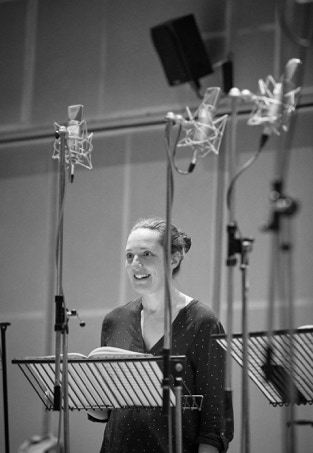The Annunciation
WITH
Tomás Luis de Victoria – Alma Redemptoris Mater (1581)
THE IMAGE
His earliest independent painting, the Annunciation, shows the youthful Leonardo striving hard – perhaps too hard – to show what he can do. Entering the ‘enclosed garden’ from the Song of Songs, the angel kneels on a carpet of wriggling plants that flower with a white purity fitting for a virgin – a message underlined by the white lily (also from the Song of Songs). His feathery wings are studied from real birds (although the pigment has deteriorated towards the wing tips). His drapery is modelled with exaggerated plasticity, as is the Virgin’s. She sits on the pavement of a rather grand palace, drawn with insistent perspective on the priming of the panel. The improbably decorative marble base of her lectern quotes motifs from ancient Roman decorative art, in the manner of his master Andrea Verrocchio. We are not meant to ask about how the Virgin’s right arm could reach from where she sits to touch the holy book. In the background, veiled with the blue haze in which Leonard delighted, is a sprightly port scene. Alert contemporaries would have recognised the characterisation of the beloved lady as the ‘star of the sea’ in the Song of Songs.
For all the detailed striving for visual effect, Leonardo centers his portrayal on the sacred message of virginal impregnation that the Angel conveys with his incisive glance, to be met with the Virgin’s decorous gesture of surprise and acquiescence.
MARTIN KEMP
———————————————————————————————————————
THE MUSIC
The Marian text of this motet is a perfect match for Leonardo’s Annunciation, also including Song of Song references: but there are also textural comparisons. Two choirs in dialogue begin separately but become increasingly entwined as a voice from one is woven into the other group, and vice versa. The resultant musical texture is a rich aural fabric, mirroring Leonardo’s famously opulent drapery.
ROBERT HOLLINGWORTH

TEXT / TRANSLATION
Alma Redemptoris mater,
quae pervia caeli porta manes,
et stella maris, succurre cadenti
surgere qui curat populo.
Tu, quae genuisti, natura mirante,
tuum sanctum Genitorem:
Virgo prius ac posterius,
Gabrielis ab ore sumens illud
Ave, peccatorum miserere.
Gracious mother of the Redeemer,
who remains the ever-open gate to heaven,
and star of the sea, help your people who fall
but try to rise again.
You who gave birth, while nature marvelled,
to your Holy Creator:
a virgin before and after,
who heard from the mouth of Gabriel that
‘Ave’: have mercy on sinners.

Clare Wilkinson
Mezzo-soprano
Credit Matthew Brodie
I FAGIOLINI
Choir 1: Anna Crookes, Richard Wyn Roberts, Matthew Long, Greg Skidmore
Choir 2: Charlotte Mobbs, Clare Wilkinson, Nicholas Hurndall Smith, Charles Gibbs